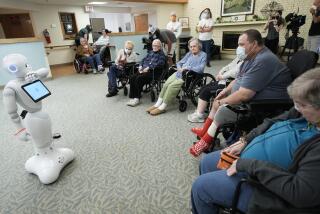Nursing Home Improvements
- Share via
* Growing up as a Korean-American, I thought the institutionalization of the elderly the most inhumane example of social inequity. I considered it an indecent breach of social commitment to our elders, a twisted, malevolent tribute to those who stood awake at night for us in our infancy and cradled our emotions through adolescence.
The thanks they receive is a weekend visit at the nursing home that slowly diminishes to once a month.
As a church youth group leader I visited many nursing homes in the early 1980s on holidays to disseminate goodwill. After every visit my peers and I would discuss how different the American “system” of caring for the elderly was compared to the Korean way.
In Korea, we seldom institutionalize the elderly. Our elders are nursed at home by family members in a familiar environment, not in small sterile rooms where the only thing they have in common with their roommates is imminent death. These were my views, even up until my first year of graduate school.
Ironically, I have since been licensed as a nursing home administrator by the state of California. In my second year of graduate school at Columbia University, I was an administrative intern at a major hospital and nursing home in New York City.
Like Judith Jacovitz (Valley Commentary, Aug. 1), I saw many residents attached to oxygen machines and in wheelchairs and some with acute dementia. During my first two weeks I was discouraged by the notion that I was training to manage an institution where people would inevitably die. This changed when I began to experience the changing face of nursing homes.
Jacovitz paints a very dismal picture of nursing homes. But what she fails to address is the changes in nursing home practices and management that has improved the quality of care even in the past decade.
The physical therapy she received would not have even been available to her in a nursing home if not for innovative programs developed to rehabilitate residents. Yes, the key word is “rehabilitate.” Companies such as Beverly Enterprises, for which I work, spearheaded programs with the primary goal to graduate the resident back to their community. Like it or not, Jacovitz is a graduate of a rehabilitation program made possible by the nursing home she resided in.
Moreover, the Department of Health and the ombudsman office work to ensure that nursing homes are providing the highest quality of care. Nursing homes are under extreme scrutiny via annual inspections by the Department of Health, and most have internal inspections.
It is unfortunate that Jacovitz had such a bad experience. All nursing homes are not alike. We come from all different backgrounds yet with a common purpose, to provide care for the elderly. We do not consider the elderly a homogeneous group. We respect their individuality and endeavor to care for them accordingly.
PETER KACY KANG
Montrose
Kang is administrator of the Montrose Nursing Center.


